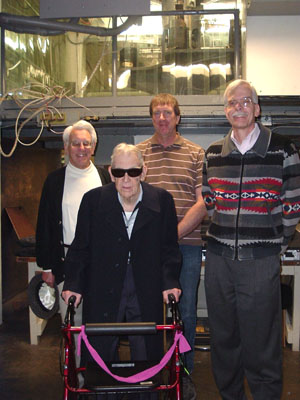« Washington Engineer - October 2005
Tour impresses 101-year-old emeritus professor

- Emeritus Professor Fred Eastman, front, one of four founding faculty members who opened the UW Department of Aeronautics & Astronautics in 1929, visited campus last May. With the 101-year-old Eastman in the Kirsten Wind Tunnel are, from the left, Jim Eastman, Eastman's 75-year-old son; Paul Robertson, '74 A&A alum and president of Aeronautical Testing Services in Arlington, Wash.; and Adam Bruckner, A&A chair. The electromagnetic force balance invented by Eastman and used in the Kirsten facility and in many other wind tunnels is visible in the background.
When 101-year-old Fred Eastman arrived on campus last spring to visit his old stomping grounds, he wasn't sure what he would find.
Eastman, one of four faculty who founded the University of Washington's Department of Aeronautics & Astronautics in 1929 and who later served as department chair, suspected he would not see much that was familiar after so many years.
“I think he was pleasantly surprised,” said Adam Bruckner, current department chair who hosted Eastman and his 75-year-old son, Jim, during a visit that included a department tour and a tribute at the spring banquet at Boeing’s Museum of Flight.
Jim Eastman agreed.
“I think he was afraid that much of what he had started would be gone,” the younger Eastman said. “But he saw the connections that are still there. He mentioned several times how impressed he was.”
The high point for Eastman was a tour of the Kirsten Wind Tunnel – a facility that he was instrumental in making possible.
When the tunnel was designed and built in 1936, it incorporated “an ingenious electromagnetic force balance” that had been invented by Fred a few years earlier, Bruckner said.
“This balance, now known as the Eastman Balance, became the model for many other wind tunnels built later,” Bruckner said. “Fred refused to patent the device, believing its use should be widely encouraged.”
As a result, “seeing ‘his’ wind tunnel – and even hearing it run – was the highlight for him,” Jim Eastman said.
During the visit, the father and son also located Fred's boyhood home in Magnolia, a Seattle suburb.
“It was still there and looks good,” Jim said. “We didn’t talk about what the current value might be. I’m sure he wouldn’t believe it if he knew.”
Back at the retirement home in Medford, Oregon, Eastman is still talking about the trip, which his son says has made him something of a celebrity among fellow residents. He has contacted Bruckner about a longstanding interest in ornithoidal propulsion, and Bruckner is looking for students interested in tackling the subject as an independent project, with Eastman as a consultant.
“He did have a model in our garage, but never got it to the testing stage,” Jim Eastman recalled. “If such a project happened, he could consult – perhaps as the oldest consultant on record?”
Don’t miss 'Engineering the Unexpected' lecture series
Purchase tickets for the lectures
The 2005 Engineering Lecture Series, Engineering the Unexpected, focuses on how UW engineers are taking the lead in designing ways to respond when disaster strikes. All lectures begin at 7 p.m. in Kane Hall, Room 110. Topics and dates are:
Nov. 1: Engineering Disaster Relief
In the first few days following the devastating tsunami in Southeast Asia, the huge influx of disaster relief efforts actually fed the chaos instead of reducing it. It’s a common problem, one that Technical Communication Professor Mark Haselkorn is working to solve as leader of team studying such scenarios. He and former engineering student Kate Hulpke will take listeners on a recent journey to Africa where UW students are not only helping distribute aid, but are learning critical logistical coordination and communications skills as part of a new certificate program. They will also address Hurricane Katrina and the storm’s aftermath as it relates to relief efforts there.
Read a news release about the UW program.
Nov. 8: Engineering Detectives: Uncovering the Causes of Catastrophe
When catastrophe strikes, UW alum Larry Anderson’s team is often called to the scene to determine why something failed and how to engineer solutions. Officials tapped his company, Exponent, when the World Trade Center collapsed and when the Bellingham pipeline exploded, looking for answers. Anderson will give an insider’s view of the detective work that goes into failure analysis and how engineers use information gleaned to make the world safer.
Nov. 15: Saving Soldiers: Robots to the Rescue
On the battlefield of the future, medics won’t be on the front lines, dodging bullets and shrapnel as they try to reach fallen soldiers to render aid. Instead, tough, high-tech robotic pods will do the job. That’s the vision of a team of UW researchers in surgery and engineering – a vision that’s quickly becoming reality. The first trial of a new surgical robot is scheduled early next year on a mountainside in Hawaii.
Read a story about the Trauma Pod project
Reservations for the lectures are now available online through the UW Alumni Association. Questions? Call the association at (206) 543-0540.
The series is co-sponsored by the College of Engineering and the UW Alumni Association.
Centennial celebrations set for EE, ME
The college will celebrate the 100th birthdays of two engineering departments next year. Alumni and friends are welcome to return to campus on April 29th for Electrical Engineering's centennial events and next fall, on Sept. 15, Mechanical Engineering will celebrate its 100th birthday. Look for more details on the COE Web site.